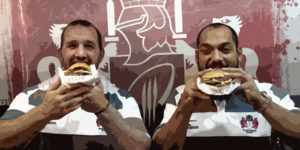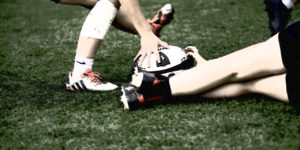Rugby is one of the few sports that involves virtually every aspect of physical fitness. This is one of the things that makes it such a unique, entertaining, and demanding sport. It’s not enough to have the fitness of a marathoner or the strength of a weightlifter – you need both attributes and more to be successful.
If you want to be fit for rugby, you need to follow a well-designed, balanced training plan that includes a variety of different types of training.
While you COULD follow a cookie-cutter, one size fits all kind of program; you’ll do much better if you honestly assess your strengths and weaknesses and design a program that addresses your specific needs.
To do this, you need to be able to quantify different aspects of fitness, so you know what you are good at and what you need to improve on.
The best way to do this is to perform a barrage of rugby-specific fitness tests at the start of each block of training so you can create bespoke workouts and tailor your training to your needs. There are lots of fitness tests to choose from but these, in our opinion, are the most representative and accessible for rugby players.
HEADS UP
Fitness tests are not without risk as they often require all-out effort. Make sure are you are fit and well before doing any of the following tests and postpone testing if you feel tired, ill, or are injured. Always warm up thoroughly before each test and use proper exercise technique throughout. To ensure the best possible results, why not use a pre-workout energy booster such as Pre-Game?
Test 1 – aerobic fitness
Although rugby is primarily a start-stop anaerobic sport, the higher your aerobic fitness, the faster you will recover from bouts of high-intensity activity and the more “gas” you’ll have as the game goes on. Lack of aerobic fitness could leave you falling behind the flow of play and unable to participate fully in the match.
Aerobic fitness is commonly expressed as your VO2 max which refers the amount of oxygen that you can take in, transport, and utilize during exercise. This reflects the efficiency of your heart, lungs, and muscles.
VO2 max is most accurately assessed in a laboratory environment using a treadmill or bike and equipment to measure the composition of inhaled versus exhaled gasses. Needless to say, this is impractical in most rugby scenarios. However, a fair estimation of VO2 max can be made using the multi-stage fitness test, also known as the beep test which involves running between two lines or cones in time to a progressively faster-recorded bleep (1). There are other variations of the beep test which can be useful in training different in-game scenarios.
To perform this standard test, you need a flat area, two lines marked 20-meters/22-yards apart, and a device for playing the pre-recorded CD or MP3 file which is available from several sources – often for free – as well as an app.
With the markers in place, the participants stand behind one of the lines facing the second line and begin running when instructed by the recording. The aim is to reach the second line just as the next bleep sounds. They then immediately turn and run back to the first marker. At the start of the test, the bleeps are quite slow, but every minute they get slight faster. The participants must continue to keep time with the bleeps until they are unwilling or unable to continue. The participant’s score is the level and number of shuttles (20m) reached before they were unable to keep up with the recording. Record the last level completed and compare to the table of norms.
Your aerobic fitness target
A score of 10.5 completed shuttles should be considered the minimum whereas a level of 13 or more is considered optimal. Loose forwards specifically are known for their elite levels of aerobic fitness. Cardio programs built for flankers and #8s can be utilized to help build your aerobic base.
Check out this video to see the All Blacks’ sevens squad taking on the bleep test:
2. Strength
Strength is vital in rugby. In many aspects of rugby play; the stronger athlete will prevail. Strength is commonly expressed as your one repetition maximum, 1RM for short, and is the maximum weight you can lift for one repetition.
In theory, any exercise can be used for testing 1RM, but the most appropriate lifts for rugby players are the bench press and the deadlift. Why these two lifts? The bench press tests the strength of the chest, shoulders, and triceps which are your primary pushing muscles. Rugby is, after all, a sport that involves a lot of pushing. The deadlift tests hip, leg, and lower back strength, arguably the most important muscles for successful rugby.
The process
To perform a 1RM test in either lift, participants should warm up gradually, increasing weights and decreasing reps up to their maximum. Rests between sets should be 3-5 minutes to allow for adequate recovery so the best score can be achieved.
For the bench press, a spotter or spotters should be on hand to give assistance in case the participant fails the lift. However, they should not touch the bar unless necessary, and any help provided disqualifies that lift. No spotters are required for the deadlift, but for the lift to count, the participant must fully extend their knees, hips, and back. 1RM testing is not without its risks and should only be done if you can perform the selected exercises with proper form.
Many online training programs are designed around building somewhat superficial muscle bulk. We recommend that rugby players focus on lifting for strength, rather than focusing on mass-building workouts. Try our six superset sessions eBook for more on rugby strength training.
For the bench press, rugby players should be able to bench press at least 1.15 times their bodyweight with 1.5 times bodyweight being desirable. For the deadlift, 1.75 times bodyweight is acceptable whereas 2.25 times body weight is desirable.(2)
Watch this video for detailed instructions for performing 1RM tests.
3. Speed
Sprinting speed is of great importance in rugby for making tackles, getting to the ball first, and, of course, outpacing the opposition to score tries. Because sprints in rugby are typically short, unlike then “gold standard” sprinting distance of 100 meters, the best assessment of sprinting speed is the 10-meter/40-meter sprint test which measures acceleration and maximum sprint speed.
To perform this test, place timekeepers 10 and 40 meters beyond a start marker. From a crouched start, players then sprint as fast as they can over the 40-meter course. The timers should record the time for the first ten meters and the total 40-meters. Electronic timing devices provide the most accurate testing results but two separate timekeepers, one at the ten-meter mark and one at the 40-meter mark, will suffice.
Each participant should make three attempts, after a thorough warm up, and the best scores recorded.
Needless to say, bigger players are often slower than smaller players i.e. props are slower than wingers. However, according to the South African Springbok fitness norms, all players should be able to cover the first 10-meters in under 1.8 seconds and the full 40-meters in under 5.65 seconds. How do you measure up?
To see just how important 40-yard sprint speed is, check out this video of Carlin Isles, the fastest man in rugby today.
4. Power
Power is force expressed at speed and, in rugby, is vital for crunching tackles, jumping in the lineout, a hard, fast shove in the scrum, and acceleration during sprinting. There are specific leg workouts for rugby players to develop their power based. Power can be tested using a force plate, but these are rarely found outside of sports science facilities. There are, however, two very useful tests you can do to assess your lower body power that are quick and easy to administer – the standing long jump and the standing vertical jump.
For the long jump, stand with your feet comfortably apart. Using your arms for extra momentum, jump forward as far as you can. Land with your feet together and then measure back from your heels to your take off point. Make several attempts and record your best jump.
Most rugby players should be able to achieve a distance of 2.5 to 2.8 meters. Hitting this mark will put you in the 51-60 percentile.
For the vertical jump, stand next to a smooth wall with your nearest arm stretched above your head. Make a mark on the wall level with the tips of your fingers. With your feet comfortably apart, squat down and then explosively jump up to touch the wall as high as possible. Measure the distance between the marks to establish the height of your jump. Make several attempts and record your best jumps.
Rugby players should strive to achieve a height of between 56-70 centimeters. To see these tests in action for yourself, check out these videos:
STANDING LONG JUMP
VERTICAL JUMP TEST
5. Flexibility
Flexibility is the range of motion available at a joint or joints. Poor flexibility can increase the risk of injury and may also decrease performance. For example, tight muscles may mean that you are forced to take shorter strides which could reduce sprinting speed.
Flexibility is important for all the muscles of the body but testing all these muscles is impractical. The hamstrings, the large muscle at the back of the thigh, is a good indicator of overall flexibility.
The most common way to assess hamstring flexibility is the sit and reach test. This involves sitting on the floor with your legs extended. Lean as far forward as you can, measuring how far you can reach past your toes. For this test, you need a device called a sit and reach box. However, the sit and reach test, because of lack of equipment, is not always practical. Some people have a tendency to round the back during the test which makes results variable.
The alternative…
A better, more accessible alternative is the Passive lying straight leg lift test (4).
- Lie on your back with one leg bent, foot on the floor close to your butt. Your other leg is straight.
- Get your partner kneel next to your straight leg. Lift it by the ankle and knee until your lower back begins to flattenr. Repeat on both sides.
- Ideally, your leg should be raised to between 80 and 90 degrees, and both legs should be equal.
There are, of course, other fitness components that you can assess such as muscular endurance, agility, and reaction time. But these rugby fitness tests represent the core physical fitness requirements necessary for safe and enjoyable rugby participation. Agility, response time, eye-hand coordination and balance are important rugby fitness tests. But these abilities should be built on the foundation of aerobic fitness, speed, strength, power, and flexibility.
REFERENCES
1. Multi-stage fitness test
2. How strong do you have to be to play professional rugby?
3. Springbok Rugby fitness norms
4. Passive lying straight leg lift


